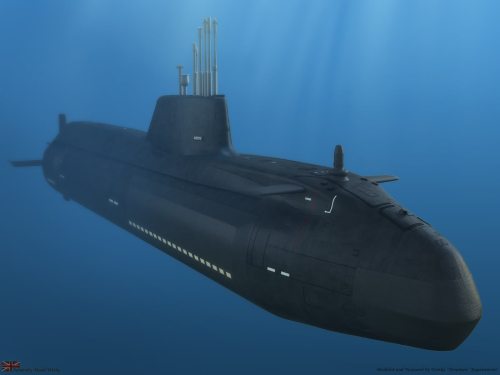Astute was the first nuclear submarine to be designed entirely in a 3D Computer Aided Design environment.
HMS Astute is the first in a program to design seven Astute-class subs to replace the Royal Navy’s aging Swiftsure and Trafalgar-class. Three similar subs (Ambush, Artful and Audacious) have already been approved to follow.
Around 6,000 people were involved in Astute’s construction at BAE’s Devonshire Dock Hall in Barrow-in-Furness, the largest shipbuilding construction complex of its kind in Europe, covering an area of 25,000 square metres. Astute’s construction required over 1 million components including 7,000 design drawings. 10,000 separate engineering requirements and 100km of pipework.
A number of technical challenges had to be overcome during the 17- year cycle from concept design to nuclear powered vessel. Not least of these was the fact that with space at an absolute premium, Astute’s machinery and equipment is three times more densely packed than that of a surface warship.
Astute was the first nuclear submarine to be designed entirely in a 3D Computer Aided Design environment. With very little time or budget for designing a prototype in the usual manner, this system of `virtual’ prototyping harnessed the power of computer test and visualisation, along with continuous design and careful systems analysis. Some areas of the Astute, such as the command deck and forward engine room, were manufactured in modules, assembled in the workshop. They were then shipped to the Devonshire dock hall and carefully placed within the hull; an example of `plug and play’ construction that not only saves time but also minimised rework.
The structure of the sub is made up of a pressure hull – a perfect cylinder with rounded dome ends demonstrating that circularity is one of the keys to surviving deep ocean pressures. There are six sections between the end domes each containing different packages of equipment, and the hull sections are meticulously welded together in a process involving more than 2km of welding, all completed without a single defect and exhaustively examined for flaws using x-ray and ultra-sonic technology.
When the first of the Astute-class subs finally entered its full service, it was the Royal Navy’s largest and most powerful nuclear attack submarines, not to mention the stealthiest.
Stealth is an important element of the submarine’s operation because combined with advance sonar it enables the submarine to track, identify and neutralise an enemy before that vessel even knows the Astute is in the vicinity. Much of the equipment is shock mounted to prevent the transmission of sound and vibration into the surrounding ocean, and active vibration technology is also used with vibrating mounts tuned to a frequency effectively cancelling out the vibration of the equipment itself. There is also a multi-bladed propulsor housed at the rear and designed for near-silent running. The whole of the submarine casing is enveloped in a very dense rubber skin to reduce sound transmission into the ocean and also to diminish the submarine’s own sonar profile. All this technology combines to make the submarine virtually invisible in the ocean.
In the cockpit itself, two Thales Optronics CM010 periscopes will ensure that Astute’s commander never has to hunch over an optical periscope. Instead, the optronics masts are fitted with thermal imaging cameras, low light video and CCD TV sensors, replacing conventional line-of-sight systems to enable the Astute to first capture and then analyse any surface images. The masts are also nonhull penetrating, significantly reducing the risk of water leakage in the event of any damage the vessel may incur.
Astute is equipped with the Thales Sonar 2076, the world’s most advanced sonar system, employing the processing power of 2,000 laptop computers to locate and identify other vessels that may be present across thousands of square miles of ocean. It is an integrated passive/active sonar that operates through hydrophones fitted to the bow, flanks and fin. However, details of Astute’s counter measures are a closely guarded secret, in particular the exact thickness of the hull which could be an indicator of dive performance. What we do know is that it is manufactured from special grade submarine steel and coated in over 39,000 rubberised acoustic tiles to mask its sonar signature.
